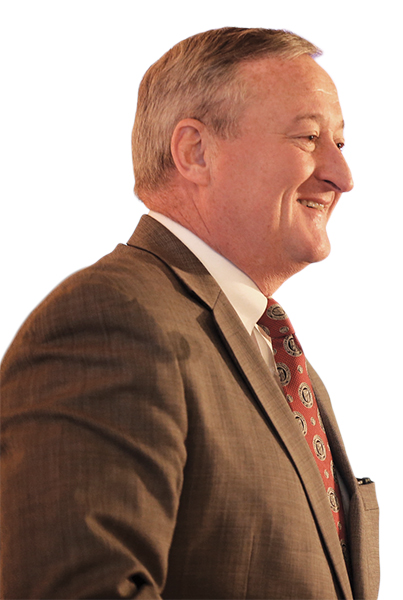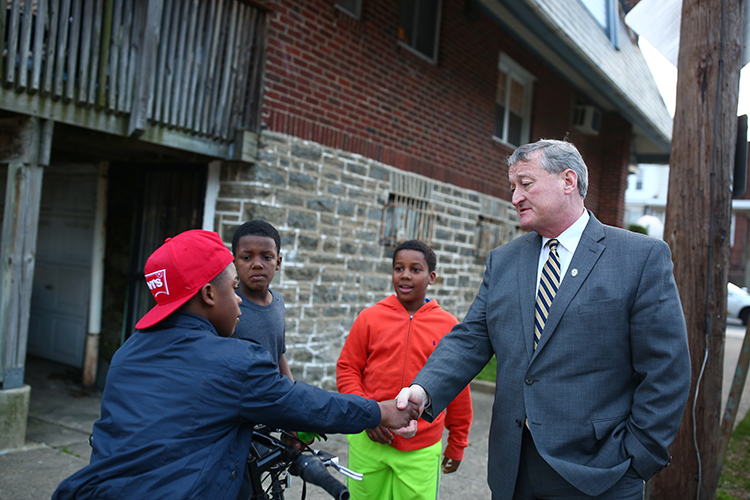Copyright City of Philadelphia. Photo by Samantha Madera
The People’s Mayor?
by Alex Vuocolo
At a campaign event in November 2015, then-mayoral-candidate Jim Kenney spoke to a packed room of Latino families and restaurant industry veterans about the importance of welcoming immigrants into the city. He stressed that newcomers were not “illegal immigrants” and condemned xenophobic and racist politics. The crowd was impressed.
On the sidewalk outside the event, Grid asked the candidate how he would protect vulnerable city residents from pollution in light of proposals to develop the city as an “energy hub” that would move fossil fuels from the western part of the state into the global market. So-called “fenceline” communities that surround Philadelphia’s current fossil fuel industry are predominantly poor people of color.
“Right now, there’s no plan. I can’t comment or criticize a ‘no plan,’ and when there is a plan, we’ll look at it and see what we can do to make it safe,” Kenney said.
For the usually blunt Kenney, the answer was cautious and a reflection of the tangled politics of energy and environmental health in a city desperate for jobs but keenly aware of the risks.
The idea that immigration, the economy and environmental issues overlap is not a new one. Indeed, the environment is increasingly seen as a factor in issues such as public health, the economy and even housing quality.
This concept, sometimes called intersectionality, has informed some of the Kenney administration’s key policy decisions in its first year, which has seen a number of initiatives aimed at tackling multiple social woes at once.
By almost any measure, the administration’s biggest achievement so far has been Rebuild. The $500 million initiative, funded in part by the contentious soda tax, will invest in early education, parks and recreation centers, and the creation of community schools, which double as hubs for social services. The city will also actively hire minority contractors for the initiatives and various capital projects, according to a recent report from Philadelphia Inquirer.
The Office of Sustainability’s Greenworks plan, a Nutter-era framework for tackling sustainability goals, has also shifted toward an intersectional approach. Though the office is still working to develop comprehensive citywide goals, the overall approach to sustainability work includes an Equity Index that will use data to identify areas of the city not yet benefiting from investments such as tree cover or access to healthful, local food. The administration will then work with city agencies, nonprofit organizations and community members to design projects targeted specifically at those areas.
A similar awareness of social equity has taken root at the Philadelphia Redevelopment Authority (PRA). Developers of city-owned land must now explain their “social impact” in their requests for proposal. Their answers will help determine whether the city chooses that developer.
“When I started in this job in April, the idea of using the public sector as a willing partner to promote social impact real estate was something that was at the front of my mind,” said Greg Heller, director of PRA. “And one way that I felt and others in the administration felt was a good way to start doing that was to use social impact as one of the ways we score project proposals.”
Heller explained that he has experienced nothing but encouragement for these kinds of ideas since joining the administration.
“This was not something that took a lot of convincing,” Heller said.
As for the energy hub idea and its connection to immigration, poverty or any social justice matter, the Kenney administration still has not taken a strong stance, partly because plans remain on the drawing board.
“There hasn’t been a significant amount of development as far as the energy hub is concerned,” said Lauren Hitt, communication director for the Mayor’s Office.
There have been some signs, however, that the concept is losing steam. The Philadelphia Regional Port Authority recently suspended bids for the development of a 195-acre section of the Delaware River waterfront. The project, known as Southport, was crucial to plans for an energy hub. Energy hub architect and Philadelphia Energy Solutions CEO Phil Rinaldi, who was one of the bidders on the project, has just announced his retirement.
Meanwhile, the state announced a $300 million capital investment in existing ports, including Packer Avenue Marine Terminal in South Philadelphia and the Tioga Marine Terminal in Port Richmond—funds that were initially planned for Southport. Jeff Theobald, executive director and CEO of the Philadelphia Regional Port Authority, says that a diversity outreach plan will help ensure that contractors and subcontractors include firms owned by women, minorities, veterans and other “traditionally underutilized groups.”
If the plan for an energy hub does move forward, it remains to be seen whether Kenney will stand up for the fenceline communities in Philadelphia with the same resolve that he’s showing to protect immigrants and other vulnerable populations.
Even as President-elect Donald Trump and Sen. Pat Toomey have proposed cutting funding to cities that protect undocumented immigrants, Kenney remains stalwart that Philadelphia will continue to be a “sanctuary city”—one that limits cooperation with federal immigration authorities.
“I am hopeful, but cautious,” Kenney said in a speech in early December. “I want everyone to understand that cities, including Philadelphia, have been the bastion of protection for minorities, LGBT people, for immigrants—and we’re not walking this back.”







